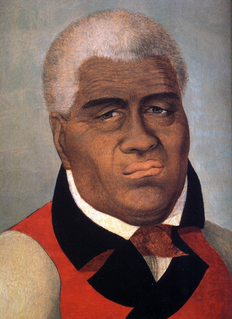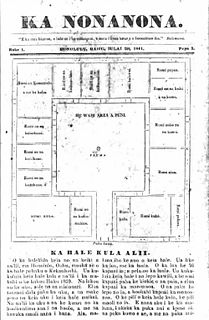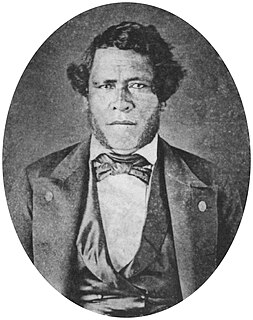
Kamehameha I, also known as Kamehameha the Great, was the conqueror and first ruler of the Kingdom of Hawaii. The state of Hawaii gave a statue of him to the National Statuary Hall Collection in Washington, D.C. as one of two statues it is entitled to install there.

Lunalilo was the sixth monarch of the Kingdom of Hawaii from his election on January 8, 1873, until his death a year later.

The Royal School is a historic school founded in 1839 in Honolulu, Hawaiʻi, as the Chiefs' Children's School. The school was renamed as the Royal School in 1846. After the boarding closed in 1850, it became a day school for children. It later became a public elementary school, and moved to its present campus in 1967.
The aliʻi were the traditional nobility of the Hawaiian islands. They were part of a hereditary line of rulers, the noho aliʻi.
The Great Māhele or just the Māhele was the Hawaiian land redistribution proposed by King Kamehameha III. The Great Māhele was one of the most important episodes of Hawaiian history, second only to the overthrow of the Hawaiian Kingdom. While intended to provide secure title to Hawaiians, it would eventually end up separating many of them from their land.

Samuel Mānaiakalani Kamakau was a Hawaiian historian and scholar. His work appeared in local newspapers and was later compiled into books, becoming an invaluable resource on the Hawaiian people, Hawaiian culture, and Hawaiian language while they were disappearing.

William Richards was a missionary and politician in the Kingdom of Hawaii.

Timoteo or Timothy Kamalehua Haʻalilio was a royal secretary and first diplomat of the Kingdom of Hawaii. He is best known for helping Hawaii in gaining recognition from Britain, France, and the United States as an independent sovereign nation.

Luther Aholo was a politician who served many political posts in the Kingdom of Hawaii. He served multiple terms as a legislator from Maui and Minister of the Interior from 1886 to 1887. Considered one of the leading Hawaiian politicians of his generation, his skills as an orator were compared to those of the Ancient Greek statesman Solon.
George Luther Kapeau was a noble and statesman in the Kingdom of Hawaii who was one of the first generation of native Hawaiians to receive a Western education at the missionary founded Lahainaluna School. Despite his obscure family status, he rose to prominence as an advisor to King Kamehameha III. He served many government posts such Royal Governor of the Island of Hawaiʻi and member of the House of Nobles.

John Mākini Kapena was a politician, diplomat and newspaper editor who served many political roles in the Kingdom of Hawaii. He served as Governor of Maui from 1874 to 1876, Minister of Finance from 1876 to 1878 and again from 1883 to 1886, Minister of Foreign Affairs from 1878 to 1880, Postmaster General from 1881 to 1883 and Collector General of Customs from 1886 to 1887. From 1874 to 1875, he accompanied King Kalākaua on his state visit to the United States to negotiate the Reciprocity Treaty of 1875. In 1882, he traveled to Tokyo as Envoy Extraordinary and Minister Plenipotentiary to the Court of Japan to negotiate Japanese immigration to Hawaii.
Jonah Kapena, also spelled Iona Kapena, was a royal advisor and statesman in the Kingdom of Hawaii who helped draft the 1840 Constitution of the Kingdom of Hawaii. In addition to his legislative career as a member of the House of Nobles, he also served as a judge and became an assistant judge of Hawaii's first Supreme Court.
Joshua Kekaulahao was a politician and judge in the Kingdom of Hawaii. His name is often spelled Kekaulahau.
Zorobabela Kaʻauwai was an early politician and judge in the Kingdom of Hawaii. Beginning as an assistant to the Hoapili, Governor of Maui, he served many political posts including Assistant Judge of the first Supreme Court of Hawaii, an original member of the Board of Commissioners to Quiet Land Titles, a multiple-term representative in the Hawaiian legislature and circuit judge for Maui. An early convert to Christianity and devout adherent of the Protestant faith, his first name is a Hawaiian form of the Biblical name Zerubbabel.

Paul (Paulo) Kanoa was a Hawaiian high chief who served many political posts in the Kingdom of Hawaii, including Governor of Kauaʻi from 1847 to 1877.

Paul Nahaolelua was a Hawaiian high chief who served many political posts in the Kingdom of Hawaii, including Governor of Maui from 1852 to 1874. In his long political career, Nahaolelua served under the reigns of five monarchs: Kamehameha III, Kamehameha IV and Kamehameha V, Lunalilo and Kalākaua.
Pius F. Koakanu was a Hawaiian high chief (aliʻi) from the island of Kauai who served as a politician during the Kingdom of Hawaii and the Kahu or Keeper of the Royal Mausoleum of Hawaii at Mauna ʻAla.
The Privy Council of the Hawaiian Kingdom, also known as the King's Privy Council of State or Queen's Privy Council of State, was a constitutionally-created body of advisers to the sovereign of the Hawaiian Kingdom from 1845 to 1893. Its members were known as privy councillors and often involved in the other branches of the government.
The Cabinet of the Hawaiian Kingdom was a body of the top executive officials appointed to advise the sovereign of the Hawaiian Kingdom from 1845 to 1893. The subsequent regimes of the Provisional Government and the Republic of Hawaii retained the structure of the cabinet and minister positions under the presidency of Sanford B. Dole from 1893 until 1898.










